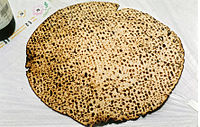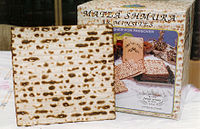Se toma un niño saludable y se lo degüella con cariño... su sangre joven es el mejor ingrediente para mátzes (pan ázimo de los judíos) [propagangda de los antisemitas árabes]
en.wikipedia.org/wiki/Matzo
Ingredients, five species of chametz, and preparation
| Matzo (Plain) Nutrition Facts |
|---|
The precise detailed religious requirements for matzah are not
universally agreed upon; for example there is disagreement over what
grains may be used, whether matzah which is wetted after being baked
then becomes chametz or not, and so on.[2] Some strictly observant Jews insist that grain for matzah must be supervised since harvesting—shmurah matzah.
At the Passover seder, it is customary to eat matzah made of flour and water only; matzah containing eggs, wine, or fruit juice in addition to water is not acceptable for use at the seder,[3] although acceptable during the remaining days of the holiday. However, most strictly Orthodox Ashkenazi Jews will not eat this kind of matzah during Passover.[citation needed]
Biblically, five specific species of grain become chametz
after wetting. The actual species are not known with certainty,
although they would necessarily have been crops that grew in the middle
east in Biblical times. When the Bible was translated into European
languages, the names of food grains common in Europe were used, some of
which were not grown in ancient Israel:[citation needed]
- Wheat, חיטה
- Barley, שעורה
- Spelt, כוסמין
- Rye, שיפון, and
- Oats (according to Rashi) (or two row barley according to Rambam's interpretation of Mishnah Kil'ayim 1:1; Yerushalmi Challah 1:1), שיבולת שועל
As more accurate historic and botanical evidence comes to light, some
scholars today propose that only the 'five grain species' native to the
Land of Israel can become chametz.[4][5] They are:
- חיטה - Chittah – durum wheat (T. durum),
- שעורה - Se’orah – barley - 2 row (Hordeum vulgare), and
- כוסמין - Kusmin - emmer wheat (T. dicoccon),
- שיפון - Shiphon - einkorn wheat (T. monococcum),
- שיבולת שועל - Shibbolet – barley – 6 row (Hordeum vulgare)
Bread wheat, spelt, rye and oats did not grow in the Land of Israel
in the biblical period, but evolved later in the northern Fertile
Crescent and Europe.[citation needed] All grains in the genus of Triticum, such as bread wheat (T. aestivum) or spelt (T. spelta), are forbidden. Oat-grain is practically gluten-free and belongs to a different tribe from wheat, spelt, rye and barley. Millet and teff are borderline; it takes a few days for them to rise.[citation needed]
However, despite this historical information, many authorities clearly
say things such as "Chometz: fermented grains (wheat, oats, barley, rye
and spelt) are all proscribed on Passover".[6]
Concerning Identification of שיבולת שועל "oats" see חמשת מיני דגן (Clarification: In modern Hebrew כסמת is used for buckwheat, which is not a grain at all.)
Matzah dough is quickly mixed and rolled out without an autolyse
step as used for leavened breads. Most forms are pricked with a fork or
a similar tool to keep the finished product from puffing like a tortilla,
and the resulting flat piece of dough is cooked at high heat until it
develops dark spots, then set aside to cool and, if sufficiently thin,
to harden to crispness. Dough made from the five grains is considered to
begin the leavening process 18 minutes from the time it gets wet;
sooner if eggs, fruit juice, or milk is added to the dough. The entire
process of making matzah takes only a few minutes in efficient modern
matzah bakeries. Noodles are now made from Passover flour and eggs, as
used for egg matzah, then baked under Rabbinical supervision.
After baking, matzah may be ground into fine or coarser crumbs, known as matzah meal, used to make matza balls and added to other foods, such as gefilte fish,
instead of flour. Kosher for Passover cakes and cookies are made with
matzah meal or a finer variety called "cake meal", which gives them a
denser texture than ordinary baked foods made with flour. Very coarse
matzo meal is known as matzo farfel.
Common and less usual varieties

Matzo-forming machine, ca. early 20th century (the Lviv Museum of the History of Religion)
Although most people have a clear idea of matza as similar to crackers, there is no requirement that matzah be crisp for any purpose, including the seder. Yemenites, and Iraqi Jews traditionally made a form of soft matza which may look like Greek pita or like a tortilla. Soft matza is made only by hand, and generally with shmurah flour, as described below, like traditional "Shmurah Matza". A problem with this matzah before the introduction of freezing is that it did not keep for more than a day or two, being subject to staling like any soft bread, not a problem with hard matzah. However, soft matzah freezes well, and is more practical than it was.[7]
Besides their shape, handmade and machine-made matza are distinctively different. Handmade hard matzo is dense and chewy, while machine-made matza is lighter and crispy. Shmurah matza is generally available only around Passover, and is more expensive. Hard shmura matzah is often a round hand-made matzah about a foot in diameter; machine-made hard matzah is usually square and much smaller.
Flavored varieties of matzah are produced commercially, such as poppyseed- or onion-flavored. Oat and spelt matzah with kosher certification are produced, an are suitable for people who cannot eat wheat. Organic wheat matzah is also available.[8] Chocolate-covered matzah is a favorite among children, although some consider it "enriched matza" and will not eat it during the Passover holiday. A quite different flat confection of chocolate and nuts that resembles matzah is sometimes called "chocolate matzah".
Matzah contains typically 111 calories per 1-ounce/28g (USDA Nutrient Database), about the same as rye crispbread.[9]
Matze (hebr. מצה, matzá; dt. Matze; Plural hebr. מצות, matzót; dt. Matzen - auch jiddisch מצה, mátze; dt. Matze; Plural jiddisch מצות, mátzes; dt. Matzen), auch ungesäuertes Brot genannt, ist ein dünner Brotfladen, der von religiösen und traditionsverbundenen Juden während des Pessachfestes gegessen wird. Matze wird aus Wasser und einer der fünf Getreidearten Weizen, Roggen, Gerste, Hafer oder Dinkel ohne Triebmittel gefertigt.





No hay comentarios.:
Publicar un comentario